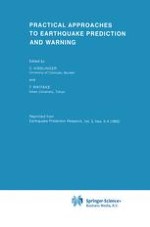1985 | OriginalPaper | Buchkapitel
Quaternary Tectonics and Damaging Earthquakes in Northeast Honshu, Japan
verfasst von : Yasuo Awata, Toshihiro Kakimi
Erschienen in: Practical Approaches to Earthquake Prediction and Warning
Verlag: Springer Netherlands
Enthalten in: Professional Book Archive
Aktivieren Sie unsere intelligente Suche, um passende Fachinhalte oder Patente zu finden.
Wählen Sie Textabschnitte aus um mit Künstlicher Intelligenz passenden Patente zu finden. powered by
Markieren Sie Textabschnitte, um KI-gestützt weitere passende Inhalte zu finden. powered by
The Quaternary tectonics of the inner belt of northeast Honshu (Tohoku district), Japan, and the neighboring offshore area of the Japan Sea are characterized by mountain blocks bounded by reverse faults 30 to 100 kilometers long and 20 to 40 kilometers wide which are arranged parallel to the major trend of the island arc. Most of the block-boundary faults began to grow in the beginning of the Pleistocene and are inferred to have had continued movement up to the present. Historical and instrumental records of seismicity strongly suggest that damaging earthquakes are associated with movement of the fault blocks. Surface manifestations of the recent movement of the block-boundary faults in this region are, however, generally not clear, probably because of the thick and soft sedimentary cover.It is proposed here that the expected magnitude of an earthquake along a block fault is a function of the area (length × width) of the respective block. If so, we can estimate the magnitude M of future earthquakes from the area A of a geologically-known fault block by the empirical formula log A (km2) = M − 4.1, instead of the estimation technique currently used based on the length of the topographically-recognized active fault. Considering that the Quaternary faults in northeast Honshu have reccurrence intervals more than 1,000-years for large displacements, the faults or fault blocks which have ruptured during the last 500 years are most unlikely to be the site of another large earthquake in the near future. Most of the fault segments constituting the Kitayuri thrust system, more than 190 kilometers in total length, are considered to have been relieved of tectonic stress by 8 earthquakes of % MathType!MTEF!2!1!+- % feaagCart1ev2aqatCvAUfeBSjuyZL2yd9gzLbvyNv2CaerbuLwBLn % hiov2DGi1BTfMBaeXatLxBI9gBaerbd9wDYLwzYbItLDharqqtubsr % 4rNCHbGeaGqiVu0Je9sqqrpepC0xbbL8F4rqqrFfpeea0xe9Lq-Jc9 % vqaqpepm0xbba9pwe9Q8fs0-yqaqpepae9pg0FirpepeKkFr0xfr-x % fr-xb9adbaqaaeGaciGaaiaabeqaamaabaabaaGcbaGaamytaiqblc % LiczaazaGaaG4naaaa!38ED!]]</EquationSource><EquationSource Format="TEX"><